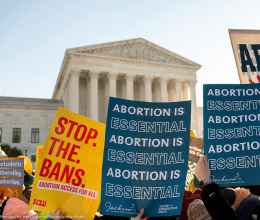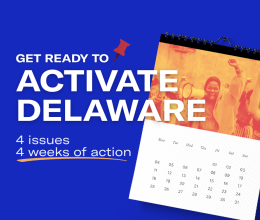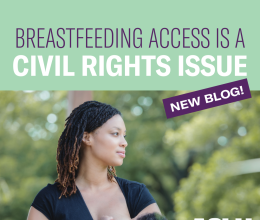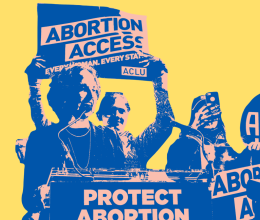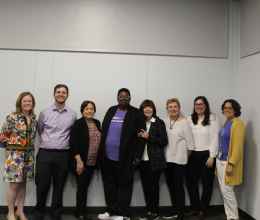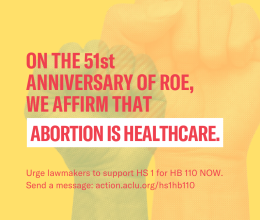Abortion bans.
Bans on gender-affirming care.
Bans on teaching histories of racism.
Voting rights restrictions.
These issues may appear unrelated at first glance, but they share common goals: giving disproportionate decision-making power to communities that politicians consider valuable, expanding white supremacy’s influence while erasing its violent history, and preserving the patriarchy by upholding gender norms and the gender binary.
The U.S. Supreme Court’s Dobbs v. Jackson decision has allowed several states to cut off abortion access entirely, with access in tens of other states hanging in the balance. But as discussions on abortion rights emerge in our homes, workplaces, classrooms, and elsewhere, we must consider the intersections of abortion rights with other social issues while envisioning and working toward a future of reproductive health, rights, and justice for all.
Looking back: Roe was the floor, not the ceiling
When Roe v. Wade was decided in 1973, the right to have an abortion became protected nationally, but the ability to access abortion care did not. As the anti-abortion movement has grown in size and scale, anti-abortion extremists have taken to local and state governments to chip away at abortion access incrementally. With local ordinances and state laws imposing unnecessary facility requirements, waiting periods, disinformation tactics, gestational limits, and other barriers to abortion care, the ability to access care became limited to those who could shoulder the logistical and financial burden of seeking an abortion. That burden could include traveling long distances, paying for childcare, and taking several days off of work.
If the fundamental right to have an abortion is written into our laws, but Medicaid won’t cover abortion care, clinics aren’t nearby and accessible by public transit, and minors must receive a judicial or physician bypass to keep their medical information private, abortion isn’t really a right for everyone — it’s a right for those who can afford to navigate the hurdles before receiving care.
If Delaware aims to become a true safe haven for abortion care, we must examine the limitations of our own laws and infrastructure. If we continue to prohibit Medicaid coverage of abortion care, don’t offer affordable transit to clinics, and limit minors’ right to privacy, we are allowing the class disparities in abortion access to continue – and as Delaware braces for an influx of patients traveling for abortion care from other states, we risk growing those disparities.
The similarities of anti-abortion and transphobic extremism
As many states have implemented abortion bans, some states who are historically hostile to abortion rights have also attempted to implement bans on gender-affirming care for binary and non-binary transgender youth. Trans kids already have higher rates of mental illness and suicide than their cisgender peers, and gender-affirming care improves their mental health outcomes.
Behind dog whistles along the lines of “protecting children,” “family values,” and “loving them both,” legislative bodies in states such as Arkansas and Texas have attempted to strip trans kids’ right to receive affirming medical care, while simultaneously creating a tumultuous landscape for people seeking abortion care. Gender-affirming care and abortion care are both avenues by which gender-marginalized people – women, non-binary people, and transgender people – are able to exercise bodily autonomy. Banning these forms of often lifesaving health care amounts to a form of state control over our bodies, health, and wellbeing.
Including gender-marginalized people, rejecting sexist gender roles
Abortion rights have historically been framed as a women’s rights issue, and it’s true that many people who seek abortion care are women. But women are not the only people who have abortions; transgender men and non-binary people seek abortion care too. And when we further explore the demographics of who can become pregnant, we also find that there are many women who cannot become pregnant; transgender women, post-menopausal women, some disabled women, and women who are infertile are some groups of women who may not seek abortion care.
Abortion rights aren’t just a gender issue – they’re a matter of reproductive freedom. Without the human right to bodily autonomy, including but not limited to accessible abortion care, we cannot decide for ourselves if, when, and how we want to become pregnant. And as abortion bans and fetal personhood laws are enforced, we may witness an increase in the criminalization of negative pregnancy outcomes. The umbrella of bodily autonomy certainly covers abortion rights, and it also covers the right to have children, receive gender-affirming care, whether to donate organs, be free from physical violence, what intimate relationships you choose to have, and much more. If we limit conversations about our reproductive rights to women’s rights, we risk casting the issue as one that only women should be concerned about; in reality, access to the full spectrum of reproductive healthcare impacts everyone in our communities.
If we tie all discussions of pregnancy and abortion care to womanhood, we risk tying womanhood to pregnancy and abortion. Whether by choice or an inability to become pregnant, many women will not experience pregnancy in their lifetimes, and the absence of pregnancy does not necessitate an absence of womanhood or motherhood. When we use non-gendered language in discussions of pregnancy and abortion, we acknowledge that a person’s experience with pregnancy does not necessarily make them a woman, and we acknowledge that being a woman doesn’t necessitate experiencing pregnancy.
When we include non-binary and binary transgender people in conversations about abortion, we reject the white supremacist notion that our reproductive abilities determine the gender roles we must take on in our families, communities, and societies. Being trans-inclusive with our language isn’t an act of excluding or erasing women. It’s an act of respect for and allyship with gender-diverse groups who are facing similar hurdles to cisgender women, and often the same hurdles, to forms of lifesaving care.
Contrary to what alarmist, transphobic rhetoric suggests, the use of non-gendered language does not aim to “cancel” women or ban the words “woman” or “women.” Expanding our language does not disinvite women from abortion advocacy – it invites other folks into it. Including trans people in our conversations about bodily autonomy is a powerful way to reject the notion that our anatomy puts us in a box to which we must conform.

